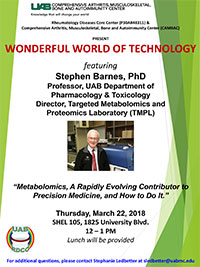Table Of Contents
- In-Gel Digest Procedure
- Methods
for Trypsin Digest
- Methods for analysis of Proteins
- Methods for analysis of Peptides
- Alternative plate spotting method for silver stained gel spots
This is the current procedure for In-Gel digests used at UAB.
(Modified from the procedure at UCSF)
In-Gel Digest Procedure
- Prepare the
following solutions:
25 mM NH4HCO3 (100 mg/50 ml)
25 mM NH4HCO3 in 50% ACN
50% ACN/5% formic acid (may substitute TFA or acetic acid)
12.5 ng/µL trypsin in 25mM NH4HCO3 (stored in 200 µl aliquots at -80oC in a freezer)
- Dice each gel slice into small pieces (1 mm2, or crush with razor
blade) and place into 0.65 mL tubes.
- Add ~50 µL (or enough to cover) of 25 mM NH4HCO3/50% ACN,
vortex and mix on the Nutator for 30 min.
- Extract the supernatant and transfer to a separate tube (to be
discarded).
- Repeat steps 3 and 4 two times. For Coomassie blue stained gels,
if gel pieces are still very blue after 1st washing,
you can rehydrate the gel pieces with ammonium bicarbonate before repeating
the washes.
- Speed Vac the gel pieces to complete dryness (~ 20 min).
- Add 20 µL trypsin solution. This volume will vary from
sample to sample.
- Incubate at room temp. for 30 min. Add 10-20 µl 25 mM NH4HCO3
if needed to cover the gel pieces.
- Spin briefly, and incubate at 37oC overnight (16-20 hrs).
Extraction of Peptides
- Briefly vortex
and spin the digest add 50 µL (enough to cover) of 50% ACN/5% formic
acid, vortex and mix on the Nutator for 30 min.
Use 1 µL of the peptide mixture plus 1 mL CHCA for preliminary analysis.
Continue extraction with remaining sample.
- Transfer the supernatant to a clean tube. Add 50 µL (enough
to cover) of 50% ACN/5% formic acid, vortex and
mix on the Nutator for 30 min. Pool extracted peptides together in one
tube. Repeat one more time.
- Vortex the extracted digests, spin and Speed Vac to reduce volume
to dryness.
- Add 5-10 µL 50% ACN/5% formic acid.
- Mix with 9µL CHCA and spot on the plate. If the protein concentration is very low, use either a 1/5 or 1/1 dilution. (An alternative spotting method using nitrocellulose can also be used - see attached
Matrices for unseparated digests:
- a-cyano-4-hydroxycinammic acid in 50% ACN/1% TFA (10 mg/mL).
- 2,5-dihydroxybenzoic acid (DHB), in 20% ACN/1% TFA (10 mg/mL).
References:
- Rosenfeld, et al., Anal. Biochem. (1992) 203, 173-179.
- Hellman, et al., Anal. Biochem. (1995) 224, 451-455.
Methods for Trypson Digest:
The protein was identified by analysis of the tryptic fragments and comparison with the NCBI database. The procedure used was adapted from that developed at UCSF (http://donatello.ucsf.edu/ingel.html). Briefly, the band was excised from a polyacrylamide gel, digested overnight with trypsin, and the peptides were extracted with 50% acetonitrile/5% formic acid. The extracts were concentrated in a speed vac and redissolved in 10 µl 50% acetonitrile/5% formic acid. The extracted peptides were mixed with the matrix a-cyano-4-hydroxycinammic acid (Aldrich, 47,687-0), spotted onto a MALDI plate, and analyzed with a Voyager DePro mass spectrometer (Applied Biosystems). The peptide masses were entered into Mascot (http://www.matrixscience.com/) and the NCBI database was searched to identify the protein.
Methods for analysis of Proteins:
Samples were analyzed in the positive mode on a Voyager Elite mass spectrometer with delayed extraction technology (PerSeptive Biosystems, Framingham MA). The acceleration voltage was set at 25kV and 10-50 laser shots were summed. Sinapinic acid (Aldrich, D13,460-0) dissolved in acetonitrile : 0.1% TFA (1:1) was the matrix used. The mass spectrometer was calibrated with apomyoglobin. Samples were diluted 1:10 with matrix, and 1 ul was pipetted onto a smooth plate.
Methods for analysis of Peptides:
Samples were analyzed in the positive mode on a Voyager Elite mass spectrometer with delayed extraction technology (PerSeptive Biosystems, Framingham MA). The acceleration voltage was set at 20kV and 100 laser shots were summed. a-cyano-4-hydroxycinnamic acid (CHCA) (Aldrich, 47,687-0) dissolved in acetonitrile : 0.1% TFA (1:1) was the matrix used. The mass spectrometer was calibrated with bradykinin, angiotensin, and neurotensin. Samples were diluted 1:10 with matrix, and 1 ul was pipetted onto a smooth plate.
Alternative plate spotting method for silver stained gel spots
MALDI plates are prepared by a method adapted from Miliotis et al. Briefly, the stainless steel plates are pre-coated with an acetone solution containing 10 mg/ml CHCA and 1 mg/ml nitrocellulose. The peptide digest sample is dissolved in 10 µl of acetonitrile / 5% formic acid (50:50) and 0.5 µl is spotted onto the matrix. The sample is washed two times with 3-5 µl 0.1% TFA and analyzed of a Voyager DePRO mass spectrometer.
Reference:
- Journal of Neuroscience Methods.
- Development of silicon microstructures and thin film MALDI target plates
for automated proteomics sample identifications.
- Tasso Miliotis, Gyorgy Marko-Varga, Johan Nilsson and Thomas Laurell.
- Dept of Analytical Chemistry, Lund University, Bos 124, SE-221 00 Lund Sweden.



